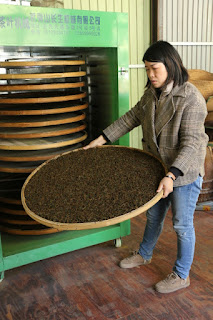Wuyi rock tea is usually picked in the middle of April. Wuyi rock tea is picked according to the standard of three leaves. Pick up the tea plants as soon as possible after picking, to prevent the tea leaves from excessive extrusion and burning.

2:
in wuyi we call this step as 倒青(dao qing )or 晒青(Shai qing)
Wuyi rock tea Withering is a metaphor for the green leaves are suntanned after the tea part of the top lying down or soft. Before withering is to spread the fresh leaves on the bamboo basket .In order to better disperse the tea, it is now replaced by big cloth or net . Whether it is appropriate to wither has a lot to do with the follow-up processing . The technology of withering is the basis of forming wuyiyan tea's fragrance and taste. Withering can rapidly increase leaf temperature, evaporate water, enhance enzyme activity, promote decomposition and transformation of macromolecule compounds and destroy chlorophyll, which has a good effect on aroma formation.
withering always happen before 11 a.m. and after 2 p.m. and the whole process of withering needs to be turned 2-3 times. The time of withering depends on the condition of tea and the intensity of light (generally about several minutes). When the temperature is too high, we should pay special attention to the change of green leaves , in case the temperature is too high to burn the leaves.)
When to stop the withering , it usually depends on whether the top leaves and sharp buds are drooping and most of the leaves are tarnished. It can also be judged by the feeling of grasping the leaves by hands and whether the withering meets the requirements. The leaves are soft, the green air is decreased, the green fragrance is exposed, the weight loss rate is 10% - 15%, and the water content of the leaves suitable for the sun is about 70%.
Zuo qing is carried out alternately by shaking and standing fermentation. Zuo qing indoor temperature control in 24-30 degrees, humidity control in 80% - 85%. The Zuo qing stage is the key link for Wuyi rock tea to express its excellent endoplasm, form good color, fragrance, taste and "green leaves and red edge".
























